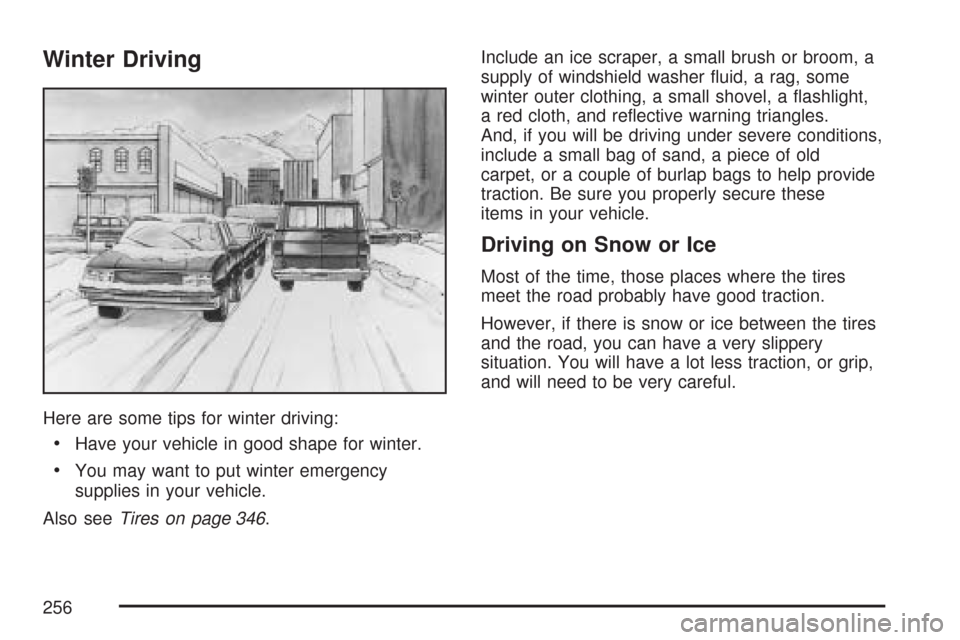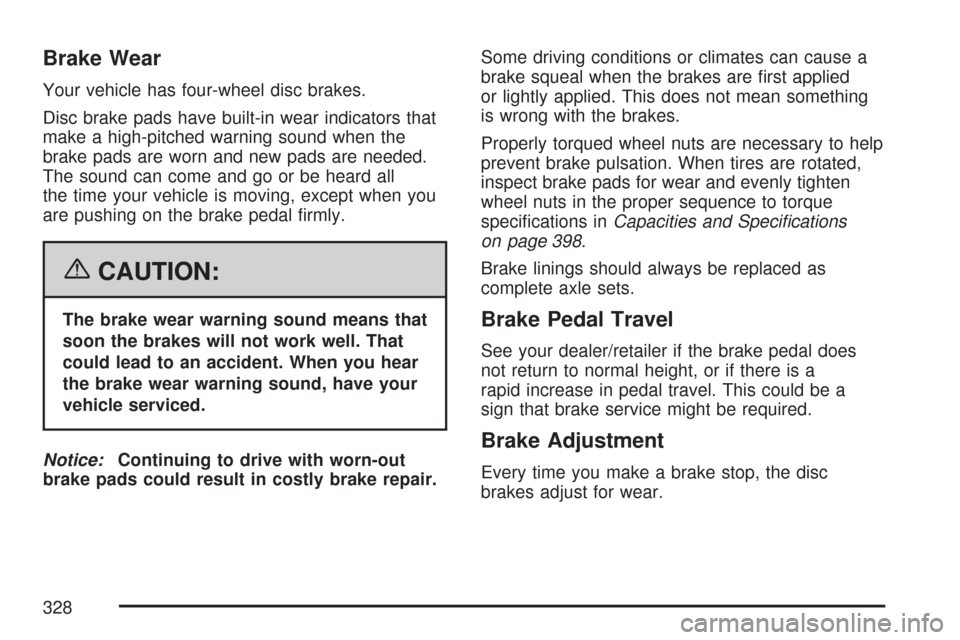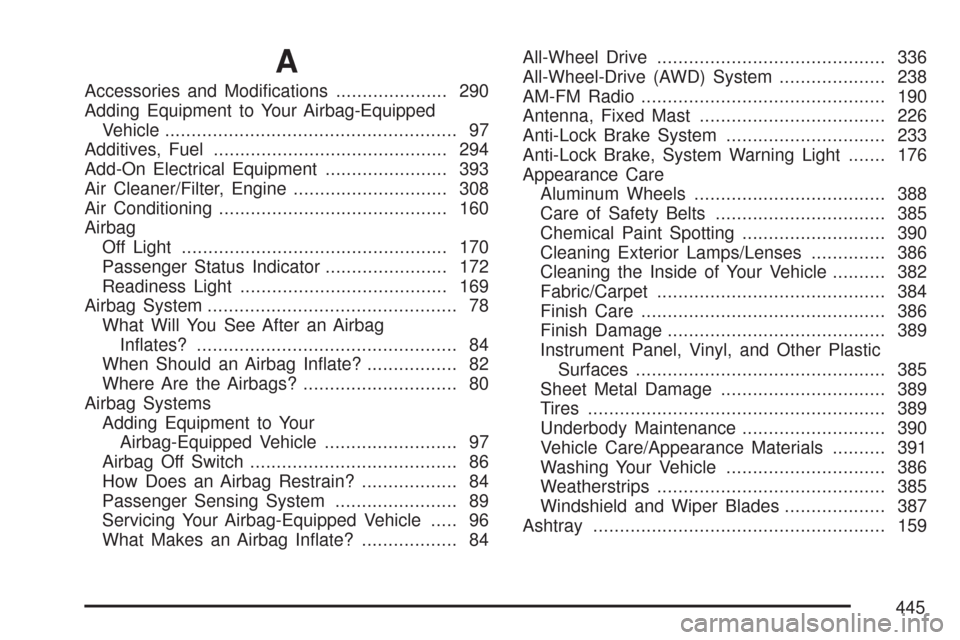2007 CHEVROLET EXPRESS PASSANGER warning light
[x] Cancel search: warning lightPage 256 of 458

Winter Driving
Here are some tips for winter driving:
•Have your vehicle in good shape for winter.
•You may want to put winter emergency
supplies in your vehicle.
Also seeTires on page 346.Include an ice scraper, a small brush or broom, a
supply of windshield washer fluid, a rag, some
winter outer clothing, a small shovel, a flashlight,
a red cloth, and reflective warning triangles.
And, if you will be driving under severe conditions,
include a small bag of sand, a piece of old
carpet, or a couple of burlap bags to help provide
traction. Be sure you properly secure these
items in your vehicle.
Driving on Snow or Ice
Most of the time, those places where the tires
meet the road probably have good traction.
However, if there is snow or ice between the tires
and the road, you can have a very slippery
situation. You will have a lot less traction, or grip,
and will need to be very careful.
256
Page 307 of 458

How to Reset the Engine Oil
Life System
The Engine Oil Life System calculates when to
change the engine oil and filter based on vehicle
use. Anytime the oil is changed, reset the
system so it can calculate when the next oil
change is required. If a situation occurs where you
change the oil prior to a change engine oil light
being turned on, reset the system.
To reset the change engine oil light:
1. Turn the ignition key to RUN with the
engine off.
2. Fully press and release the accelerator pedal
slowly three times within five seconds.
3. If the Change Engine Oil light flashes for
five seconds, the system is reset.
4. Turn the key to LOCK.
If the change engine oil light comes back on when
you start your vehicle, the engine oil life system
has not reset. Repeat the procedure. If it still does
not reset, see your dealer/retailer for service.
SeeChange Engine Oil Light on page 183.
What to Do with Used Oil
Used engine oil contains certain elements that can
be unhealthy for your skin and could even cause
cancer. Do not let used oil stay on your skin for very
long. Clean your skin and nails with soap and
water, or a good hand cleaner. Wash or properly
dispose of clothing or rags containing used engine
oil. See the manufacturer’s warnings about the use
and disposal of oil products.
Used oil can be a threat to the environment.
If you change your own oil, be sure to drain all
the oil from the filter before disposal. Never
dispose of oil by putting it in the trash, pouring it
on the ground, into sewers, or into streams or
bodies of water. Instead, recycle it by taking it
to a place that collects used oil. If you have
a problem properly disposing of used oil, ask
your dealer/retailer, a service station, or a local
recycling center for help.
307
Page 312 of 458

How to Add Automatic
Transmission Fluid
Refer to the Maintenance Schedule to determine
what kind of transmission fluid to use. See
Recommended Fluids and Lubricants on page 415.
Using a funnel, add fluid down the transmission
dipstick tube only after checking the transmission
fluid while it is hot. A cold check is used only
as a reference. If the fluid level is low, add only
enough of the proper fluid to bring the level up to
the HOT area for a hot check. It does not take
much fluid, generally less than one pint (0.5 L).
Do not overfill.
Notice:Use of the incorrect automatic
transmission �uid may damage your vehicle,
and the damages may not be covered by
your warranty. Always use the automatic
transmission �uid listed inRecommended
Fluids and Lubricants on page 415.
•After adding fluid, recheck the fluid level as
described under “How to Check Automatic
Transmission Fluid,” earlier in this section.
•When the correct fluid level is obtained, push
the dipstick back in all the way; then flip the
handle down to lock the dipstick in place.
Engine Coolant
If your vehicle has the DURAMAX®Diesel engine,
see the DURAMAX®Diesel manual for more
information.
The cooling system in your vehicle is filled with
DEX-COOL
®engine coolant. This coolant is
designed to remain in your vehicle for five years
or 150,000 miles (240 000 km), whichever
occurs first, if you add only DEX-COOL
®
extended life coolant.
The following explains your cooling system and
how to add coolant when it is low. If you have
a problem with engine overheating, seeEngine
Overheating on page 315.
A 50/50 mixture of clean, drinkable water and
DEX-COOL
®coolant will:
•Give freezing protection down to−34°F (−37°C).
•Give boiling protection up to 265°F (129°C).
•Protect against rust and corrosion.
•Help keep the proper engine temperature.
•Let the warning lights and gages work as
they should.
312
Page 328 of 458

Brake Wear
Your vehicle has four-wheel disc brakes.
Disc brake pads have built-in wear indicators that
make a high-pitched warning sound when the
brake pads are worn and new pads are needed.
The sound can come and go or be heard all
the time your vehicle is moving, except when you
are pushing on the brake pedal firmly.
{CAUTION:
The brake wear warning sound means that
soon the brakes will not work well. That
could lead to an accident. When you hear
the brake wear warning sound, have your
vehicle serviced.
Notice:Continuing to drive with worn-out
brake pads could result in costly brake repair.Some driving conditions or climates can cause a
brake squeal when the brakes are first applied
or lightly applied. This does not mean something
is wrong with the brakes.
Properly torqued wheel nuts are necessary to help
prevent brake pulsation. When tires are rotated,
inspect brake pads for wear and evenly tighten
wheel nuts in the proper sequence to torque
specifications inCapacities and Speci�cations
on page 398.
Brake linings should always be replaced as
complete axle sets.Brake Pedal Travel
See your dealer/retailer if the brake pedal does
not return to normal height, or if there is a
rapid increase in pedal travel. This could be a
sign that brake service might be required.
Brake Adjustment
Every time you make a brake stop, the disc
brakes adjust for wear.
328
Page 361 of 458

Uniform Tire Quality Grading
Quality grades can be found where applicable on
the tire sidewall between tread shoulder and
maximum section width. For example:
Treadwear 200 Traction AA Temperature A
The following information relates to the system
developed by the United States National Highway
Traffic Safety Administration (NHTSA), which
grades tires by treadwear, traction, and
temperature performance. This applies only to
vehicles sold in the United States. The grades are
molded on the sidewalls of most passenger car
tires. The Uniform Tire Quality Grading (UTQG)
system does not apply to deep tread, winter-type
snow tires, space-saver, or temporary use
spare tires, tires with nominal rim diameters of
10 to 12 inches (25 to 30 cm), or to some
limited-production tires.
While the tires available on General Motors
passenger cars and light trucks may vary with
respect to these grades, they must also conform
to federal safety requirements and additional
General Motors Tire Performance Criteria (TPC)
standards.
Treadwear
The treadwear grade is a comparative rating
based on the wear rate of the tire when tested
under controlled conditions on a specified
government test course. For example, a tire
graded 150 would wear one and a half (1.5) times
as well on the government course as a tire
graded 100. The relative performance of tires
depends upon the actual conditions of their use,
however, and may depart significantly from
the norm due to variations in driving habits, service
practices, and differences in road characteristics
and climate.
Traction – AA, A, B, C
The traction grades, from highest to lowest, are AA,
A, B, and C. Those grades represent the tire’s
ability to stop on wet pavement as measured under
controlled conditions on specified government test
surfaces of asphalt and concrete. A tire marked C
may have poor traction performance.
Warning:The traction grade assigned to this tire
is based on straight-ahead braking traction
tests, and does not include acceleration, cornering,
hydroplaning, or peak traction characteristics.
361
Page 445 of 458

A
Accessories and Modifications..................... 290
Adding Equipment to Your Airbag-Equipped
Vehicle....................................................... 97
Additives, Fuel............................................ 294
Add-On Electrical Equipment....................... 393
Air Cleaner/Filter, Engine............................. 308
Air Conditioning........................................... 160
Airbag
Off Light.................................................. 170
Passenger Status Indicator....................... 172
Readiness Light....................................... 169
Airbag System............................................... 78
What Will You See After an Airbag
Inflates?................................................. 84
When Should an Airbag Inflate?................. 82
Where Are the Airbags?............................. 80
Airbag Systems
Adding Equipment to Your
Airbag-Equipped Vehicle......................... 97
Airbag Off Switch....................................... 86
How Does an Airbag Restrain?.................. 84
Passenger Sensing System....................... 89
Servicing Your Airbag-Equipped Vehicle..... 96
What Makes an Airbag Inflate?.................. 84All-Wheel Drive........................................... 336
All-Wheel-Drive (AWD) System.................... 238
AM-FM Radio.............................................. 190
Antenna, Fixed Mast................................... 226
Anti-Lock Brake System.............................. 233
Anti-Lock Brake, System Warning Light....... 176
Appearance Care
Aluminum Wheels.................................... 388
Care of Safety Belts................................ 385
Chemical Paint Spotting........................... 390
Cleaning Exterior Lamps/Lenses.............. 386
Cleaning the Inside of Your Vehicle.......... 382
Fabric/Carpet........................................... 384
Finish Care.............................................. 386
Finish Damage......................................... 389
Instrument Panel, Vinyl, and Other Plastic
Surfaces............................................... 385
Sheet Metal Damage............................... 389
Tires........................................................ 389
Underbody Maintenance........................... 390
Vehicle Care/Appearance Materials.......... 391
Washing Your Vehicle.............................. 386
Weatherstrips........................................... 385
Windshield and Wiper Blades................... 387
Ashtray....................................................... 159
445
Page 446 of 458

Audio System.............................................. 187
AM-FM Radio.......................................... 190
Care of Your Cassette Tape Player.......... 224
Care of Your CD Player........................... 226
Care of Your CDs.................................... 225
Chime Level Adjustment........................... 226
Fixed Mast Antenna................................. 226
Radio with Cassette and CD.................... 198
Radio with CD......................................... 193
Radio with Six-Disc CD............................ 211
Setting the Time with Radio Data
Systems (RDS)..................................... 189
Setting the Time without Radio Data
Systems (RDS)..................................... 189
Theft-Deterrent Feature............................ 223
Understanding Radio Reception............... 224
Automatic Transmission
Fluid........................................................ 309
Operation................................................. 125
B
Battery........................................................ 329
Run-Down Protection............................... 158
Before Leaving on a Long Trip.................... 252Brake
Emergencies............................................ 235
Parking.................................................... 128
Brakes........................................................ 325
System Warning Light.............................. 175
Braking....................................................... 232
Braking in Emergencies............................... 235
Break-In, New Vehicle................................. 119
Bulb Replacement....................................... 340
Center High-Mounted Stoplamp
(CHMSL).............................................. 342
Front Turn Signal, Sidemarker and
Parking Lamps..................................... 342
Halogen Bulbs......................................... 340
Headlamps............................................... 340
Replacement Bulbs.................................. 344
Taillamps.................................................. 343
Buying New Tires........................................ 358
C
Calibration................................................... 134
California Fuel............................................. 293
California Proposition 65 Warning................ 291
Canadian Owners........................................... 3
446
Page 447 of 458

Capacities and Specifications...................... 398
Carbon Monoxide......................132, 256, 269
Care of
Safety Belts............................................. 385
Your Cassette Tape Player....................... 224
Your CD Player........................................ 226
Your CDs ................................................. 225
Cargo Door Relocking................................. 109
Center High-Mounted Stoplamp (CHMSL).... 342
Center Passenger Position, Safety
Belts................................................... 33, 34
Chains, Tire................................................. 364
Charging System Light................................ 174
Check
Engine Light............................................ 178
Gages Warning Light............................... 185
Checking Things Under the Hood................ 300
Chemical Paint Spotting.............................. 390
Child Restraints
Child Restraint Systems............................. 47
Infants and Young Children........................ 44
Lower Anchors and Tethers for Children..... 54
Older Children........................................... 41
Securing a Child Restraint in a Center
Seat Position.......................................... 66Child Restraints (cont.)
Securing a Child Restraint in a Rear
Outside Seat Position or the Second
Row Center Seat Position...................... 63
Securing a Child Restraint in the Right
Front Seat Position.......................... 68, 72
Where to Put the Restraint........................ 52
Chime Level Adjustment.............................. 226
Cigarette Lighter.......................................... 159
Cleaning
Aluminum Wheels.................................... 388
Exterior Lamps/Lenses............................. 386
Fabric/Carpet........................................... 384
Finish Care.............................................. 386
Inside of Your Vehicle.............................. 382
Instrument Panel, Vinyl, and Other Plastic
Surfaces............................................... 385
Tires........................................................ 389
Underbody Maintenance........................... 390
Washing Your Vehicle.............................. 386
Weatherstrips........................................... 385
Windshield and Wiper Blades................... 387
Climate Control System............................... 160
Outlet Adjustment..................................... 162
Rear Air Conditioning and Heating
System................................................. 164
Rear Heating System............................... 163
447